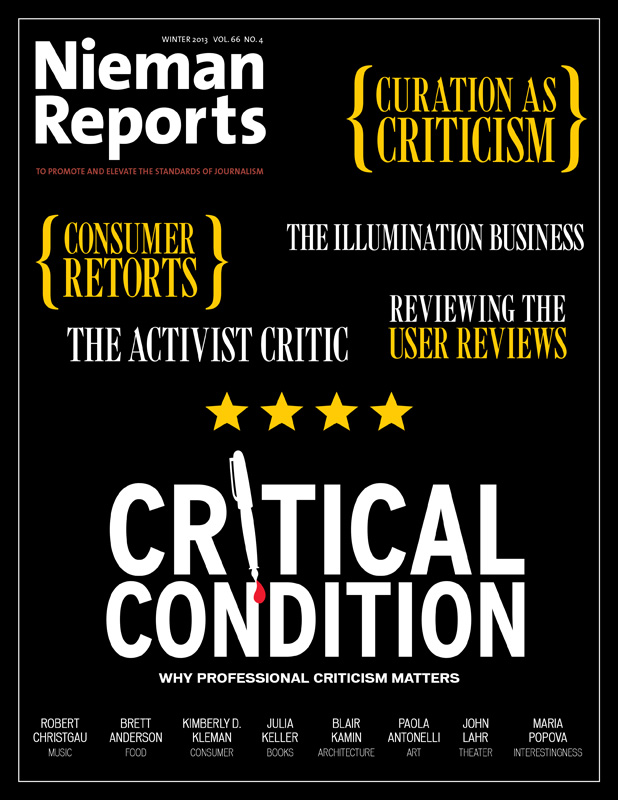“If you are counting full-time critic jobs at newspapers, you may as well count tombstones.” That was the response of Johanna Keller, director of the Goldring Arts Journalism Program at Syracuse University’s S.I. Newhouse School of Public Communications, to a Nieman Reports query about the number of professional critics employed at dailies around the country.
The figures on newspaper critics (News flash: They’re not good) are one indication of the state of criticism today, but they are not the only one. Study Arts & Letters Daily or Metacritic.com if you want proof that there’s still plenty of quality professional criticism out there. The challenge is, as Keller points out, “there are new genres of arts journalism that make the old forms of print criticism obsolete. While it is easy to count jobs lost, it is almost statistically impossible to get numbers on jobs created because they do not look like the old jobs and they are not at the same institutions.”
This shift in critical mass is illustrated by the stories that bookend our cover package: Iconic rock critic Robert Christgau, in conversation with Times-Picayune restaurant critic and current Nieman Fellow Brett Anderson, started out in the 1960s—in print, of course—at The Village Voice but now writes primarily for two online outfits, the Barnes & Noble Review and MSN, while Maria Popova created a job for herself as founder and editor of the website Brain Pickings, where she mashes up aspects of criticism and curation. The complementary and sometimes combative roles of critic and curator are also the subject of the essay by Paola Antonelli, senior curator in MoMA’s Department of Architecture and Design, who writes about the critical reception of the Museum of Modern Art’s controversial recent acquisition of 14 video games. Julia Keller, a 1998 Nieman Fellow and 2005 Pulitzer winner for feature writing, addresses another creative nexus: her dual identity as novelist and book critic.
Many blame crowdsourced review sites for crowding out the voices of professionals. But Kimberly D. Kleman, editor in chief of Consumer Reports, describes how she uses user reviews to extend and enhance her staff’s rigorous reporting and testing. And our profile of Pulitzer Prize-winning architecture critic and current Nieman Fellow Blair Kamin explores how he schooled Harvard students in the critical thinking skills we all need, as consumers and as citizens. Finally, John Lahr, longtime drama critic for The New Yorker, makes a passionate argument for the critic as cultural caretaker.
T.S. Eliot described criticism as the “instinctive activity of the civilized mind.” As we trust our cover stories show, criticism’s condition is critical—to informing and inspiring the public and to keeping our cultural conversations alive.
James Geary is editor of Nieman Reports and deputy curator of the Nieman Foundation for Journalism.



